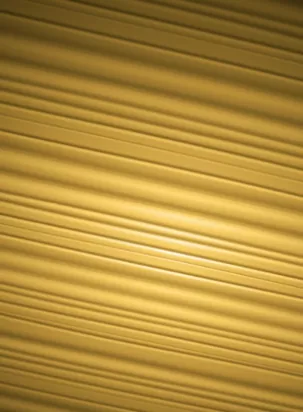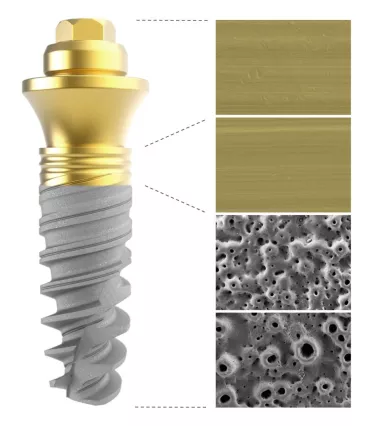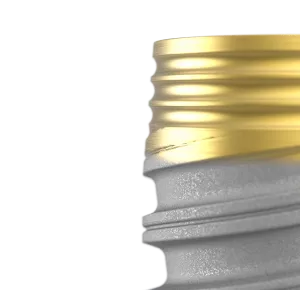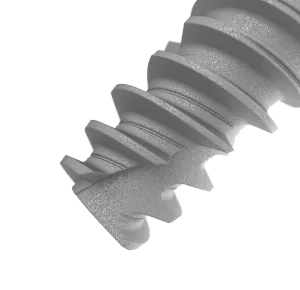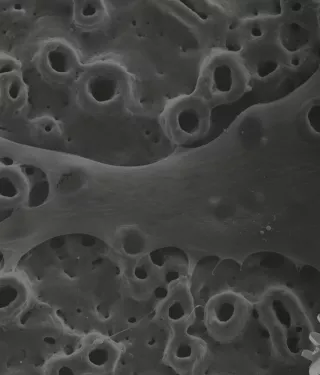
Welcome to the Mucointegration™ era
Surface science is taking tissue integration solutions to the next level.
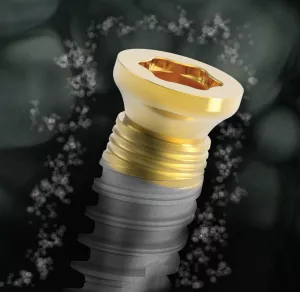
Nobel Biocare introduces the Xeal abutment surface and TiUltra implant surface, derived from decades of applied anodization expertise. From abutment to implant apex, surface chemistry and topography have been reimagined to optimize tissue integration at every level. Going beyond the mastery of osseointegration alone, Nobel Biocare enters the Mucointegration™ era.
Xeal: The pioneering Mucointegration™ surface
Dense soft-tissue contact with an abutment can act as a barrier to protect the underlying bone and is the basis for long-term tissue health and stability.1–4
Xeal is a pioneering surface for soft tissue integration that demonstrates a statistically significant increase in soft tissue height compared to machined abutments.*
A smooth, non-porous, nanostructured and anodized surface, Xeal possesses surface chemistry and topography that are specially designed to promote soft tissue attachment.*
TiUltra: More than roughness
When it comes to osseointegration, treatment success with implants that have a moderately rough anodized surface is well proven.5,6 Now, Nobel Biocare’s extensive expertise in anodization technology has led to the creation of TiUltra, an ultra-hydrophilic, multi-zone implant surface* that goes beyond roughness alone – it grasps the power of chemistry too.
TiUltra’s precisely tailored surface chemistry is achieved by anodizing the surface with a specific electrolytic solution. This solution enhances the chemical composition of the oxide layer to positively influence the interaction between surface and proteins.
For ideal integration and long-term tissue stability, different tissues demand different surfaces. To meet this need, TiUltra’s topography changes gradually from a minimally rough, non-porous, and nanostructured collar to a moderately rough and porous apex.* Fundamentally, it respects the natural transition from hard, dense cortical bone to spongy, porous cancellous bone to achieve the ultimate goal of both early osseointegration and long-term bone stability.*
Pristine surface from production to placement
The pristine surface chemistry and hydrophilicity of Xeal and TiUltra, achieved with Nobel Biocare’s extensive expertise in implant surface, are preserved throughout shelf-life by a Protective Layer, which dissolves when in contact with any liquid, such as blood.* This layer ensures that the quality of implant and abutment surface is maintained from production to placement – for the ultimate benefit of the patient.
Surface science matters
Nobel Biocare makes no compromise in maintaining an unshakeable focus on deep science behind new solutions. Building on the foundation of nearly two decades’ research supporting the success of anodized-surface implants, rigorous science and testing has been a key driving force behind the creation of Xeal and TiUltra, on a fundamental mission towards long-term treatment success. While some manufacturers may be satisfied with introducing solutions with little or no evidence, it’s scientific scrutiny that really counts for Nobel Biocare.
For an in-depth insight into the evidence supporting Xeal and TiUltra, a dedicated supplement to Clinical Implant Dentistry and Related Research, provides a compelling story from design and in vitro characterization, to behavior in animal studies, and most notably, to the pre-market clinical study.
References
The Xeal surface is available for the On1 Base and the Multi-unit Abutment. TiUltra is available on Nobel Biocare’s best-selling NobelActive, NobelParallel CC and NobelReplace CC implants.
*Data on file, Nobel Biocare
1 Rompen E, Domken O, Degidi M, et al. The effect of material characteristics, of surface topography and of implant components and connections on soft tissue integration: a literature review. Clin Oral Implants Res 2006;17 Suppl 2:55-67.
Read on PubMed
2 Alva H, Prasad KD, Prasad AD. Bioseal: The physiological and biological barrier for osseointegrated supported prosthesis. J Dent Implant 2013;3:148-52
3 Touati B, Rompen E, Van Dooren E. A new concept for optimizing soft tissue integration. Pract Proced Aesthet Dent. 2005;17(10):711-715.
4 Schupbach P, Glauser R. The defense architecture of the human periimplant mucosa: a histological study. J Prosthet Dent. 2007 Jun;97(6 Suppl):S15-25.
Read on PubMed
5 Wennerberg , Albrektsson T, Chracanovic B. Long-term clinical outcome of implants with different surface modification. Eur J Oral Implantol 2018;11(Suppl 1): S123–S136.
Read on PubMed
6 Karl M and Albrektsson T. Clinical performance of dental implants with a moderately rough (TiUnite) surface: A meta-analysis of prospective clinical studies, Int J Oral Maxillofac Implants. 2017;32(4):717-734.
Read on PubMed
